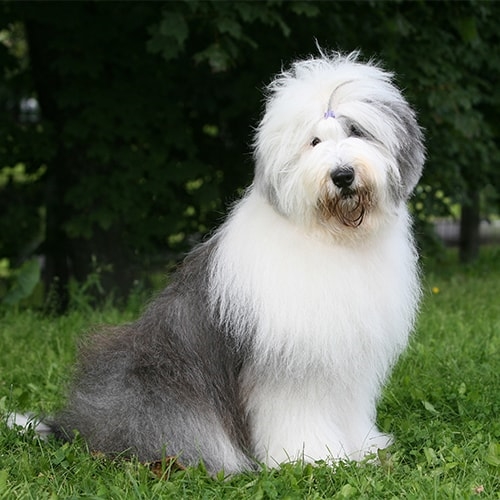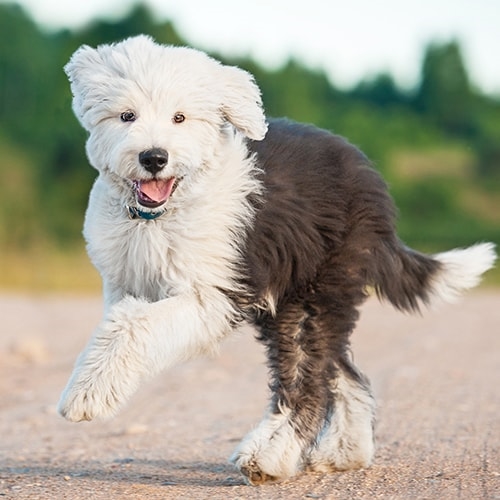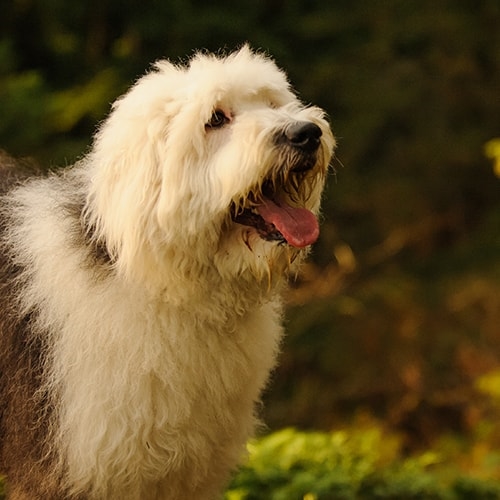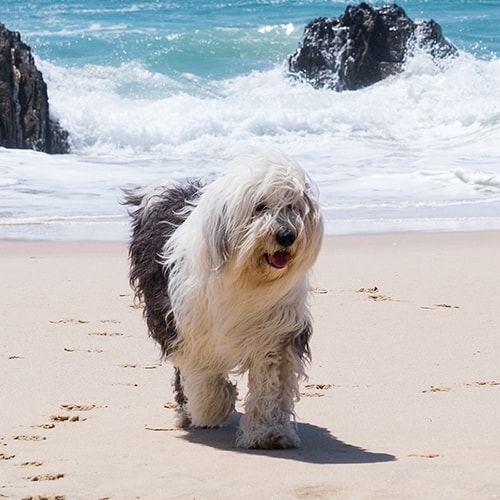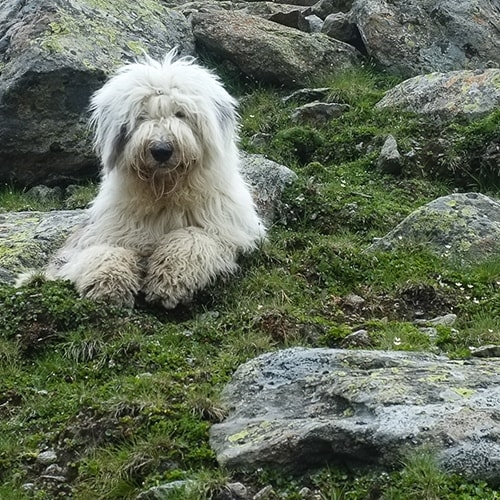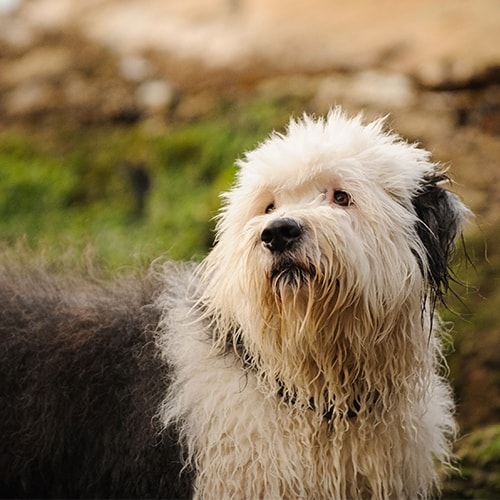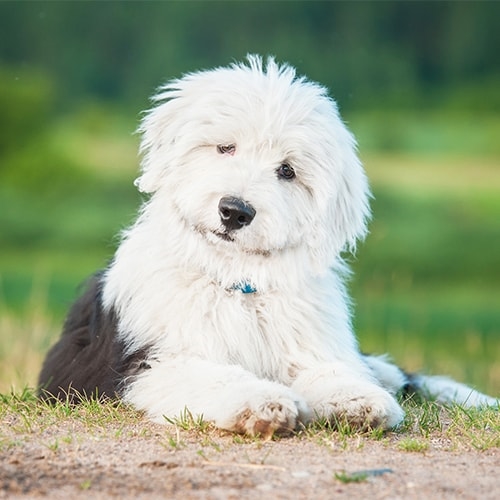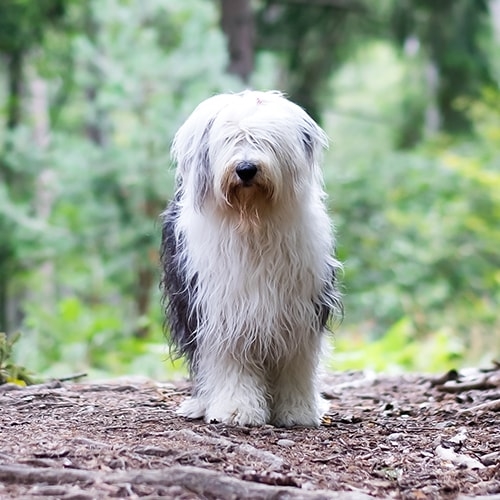| Size | Large |
|---|---|
| Average height | 56-61 cm |
| Average weight | 27-30 kg |
| Average lifespan | Over 10 years |
| Minimum exercise (per day) | 2 hours |
| Coat length | Long |
| Minimum cost (per month) | £105 |
Old English Sheepdogs are big and beautiful dogs who love spending time with their owners and being as active as possible. They’re known for their iconic looks and general hairiness, along with their loveable and affectionate natures.
They’re an energetic breed and suit really active homes where they can get lots of opportunity to play, run and go exploring! They suit households with lots of space and owners who are ideally around all day long. Old English Sheepdogs are known for forming close bonds with their owners so tend to worry if they are separated from you!
Common health problems in Old English Sheepdogs
Old English Sheepdogs were traditionally bred for herding, but can adapt really well to family life in the right household. Unfortunately, they are prone to certain health problems relating to their breed like many other purebred dogs.
If you are thinking of buying an Old English Sheepdog puppy, make sure the parents of your puppy have had the relevant health screening to reduce the chances of your puppy being affected by certain conditions. We’d recommend looking for a Kennel Club Assured Breeder as they meet extra requirements which will benefit your puppy’s health.
Some of the conditions Old English Sheepdogs may develop include:
- Hip dysplasia – where the hip joint doesn’t fit together perfectly, which will eventually lead to arthritis. Before breeding, dogs should be screened by x-rays through the BVA/Kennel Club Hip Dysplasia Scheme.
- Gastric Dilatation Volvulus (GDV) – often known as ‘bloat’, where your dog’s stomach can bloat and twist around on itself.
- Deafness – puppies can be tested from six weeks.
- Eye problems, including hereditary cataracts and congenital hereditary cataracts. There is screening available for both of these conditions.
- Primary Ciliary Dyskinesia – a disease that can lead to breathing issues. Parents should be DNA tested.
If you want to minimise the risk of your dog getting problems due to exaggerated features, you can read our advice on choosing a pedigree dog.
Caring for your Old English Sheepdog
Old English Sheepdogs have such easy-going personalities that they have quickly become popular family pets. They can be playful which is why they suit active households with lots going on for them to get stuck into! Old English Sheepdogs can be easy to train in the right hands as they are very clever and keen to learn.
As with most dogs, Old English Sheepdogs don’t do well if left alone. They are known for getting very attached to their owners and will worry and get stressed if you go out without them. This is why they ideally suit homes where someone is around all the time.
Old English Sheepdogs and barking
How much noise your Old English Sheepdog makes will be down to their individual personality and training. Any dog is likely to vocalise at some point or another – it’s completely natural behaviour. Old English Sheepdogs are known for liking the sound of their own voices though and are likely to let you know about all the comings and goings in the home. They have a loud, deep bark so remember this if you have close neighbours! If you’re having problems with excessive noise or barking, we recommend seeking the advice of an accredited behaviourist.
Training and socialisation
As with other dogs bred for herding, Old English Sheepdogs are very intelligent and are quick to pick up new things. This said, they can be strong-willed at times, which is why it’s important to start positive, reward-based training from a young age. As with any training, consistency is key and it’s best to handle your Old English Sheepdog with a firm but fair attitude. You may benefit from taking your Old English Sheepdog puppy to training classes – you can find an accredited class online.
Because of their easy-going personalities, a well-socialised Old English Sheepdog is likely to grow into a happy and confident dog. You’ll need to socialise your Old English Sheepdog with lots of people, experiences and other dogs to make sure they develop well-rounded personalities.
Old English Sheepdogs have lots of energy so need someone around to keep them active for a good portion of the day. They can suffer from separation anxiety when left alone, even for very short periods, so make sure they have company or go into doggy day-care if you are out at all.
Exercise
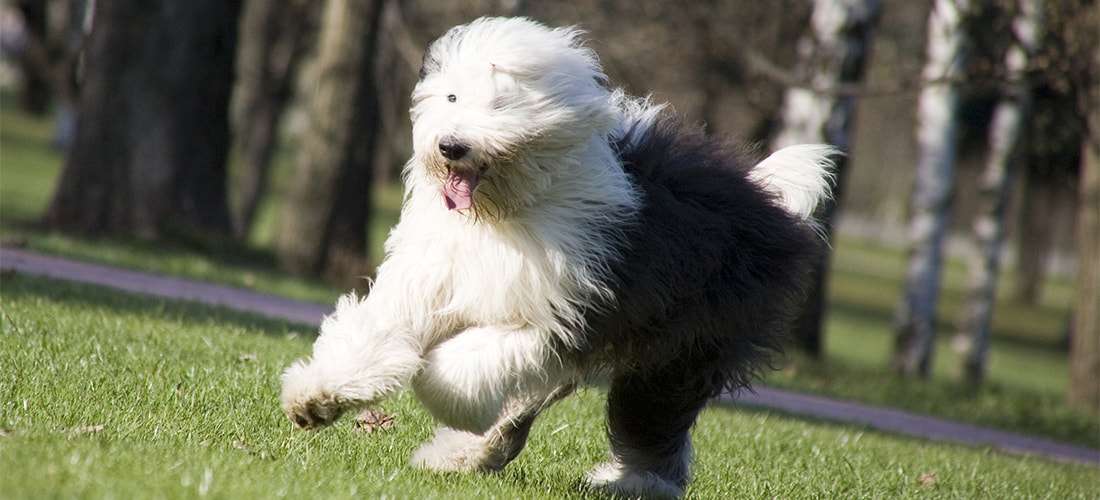
As with other herding breeds, Old English Sheepdogs are extremely high energy and active dogs. They suit active households really well so if you love getting out and about, they’re the breed for you! Ideally, a large, secure garden or walks in areas with lots of open space are perfect for Old English Sheepdogs.
Your Old English Sheepdog will need a minimum of two hours exercise every day. This should be split into several walks with off-lead time in a secure area, spread across the day. Remember to keep a tight grip on your dog’s lead while out, as the herding and prey drive is quite strong in Old English Sheepdogs (be especially careful around livestock in fields!).
On top of this, your Old English Sheepdog will need interesting and varied training sessions with plenty of playtime in between! They are known to be fun loving so stock up on dog friendly toys and make sure you spend loads of time playing with them. They’ll also need free time in a large, secure garden to chill out and do what they want for a little while.
Grooming
If you hadn’t already guessed, Old English Sheepdogs are very high maintenance. They have long fur which will need a daily brush to make sure it doesn’t get matted and tangled. Some owners prefer to keep their Old English Sheepdog’s coat shorter as this helps keep them clean and manageable. In this case, you will need to take your dog to a professional groomer for a regular trim every six weeks or so.
That said, if you make sure you regularly brush your Old English Sheepdog, they’ll shed surprisingly little. So keeping on top of the grooming routine is a must for both of you! For more advice on keeping pet hair to a minimum around the home, visit our blog.
Old English Sheepdogs and children
Old English Sheepdogs are known for being sociable and kind dogs so tend to get on really well with children. This said, it’s important to remember that they are large dogs and can be a little excitable at times. For this reason they are better suited to families with older children who can recognise when playtime is getting too much. It’s important to always supervise your dog with children and vulnerable adults to avoid any accidents.
Old English Sheepdogs and other pets
Old English Sheepdogs are sociable dogs and are generally friendly around other dogs. As long as you socialise your puppy with lots of other dogs, they should grow up to be happy around all different breeds.
Old English Sheepdogs do have strong hunting instincts, so it’s probably better not to have smaller pets with your dog. They will generally get along well with a cat they have grown up with, but this definitely won’t stop them chasing any unfamiliar cats! Always supervise your dog with other pets.
Food
Your Old English Sheepdog’s diet will vary depending on their age. You’ll need to feed them a complete, balanced dog food to keep them slim and healthy.
Your vet will be able to tell you how much your Old English Sheepdog should be eating. As a large breed, remember that you might find your food supplies go down much faster than with smaller breeds! You should feed them a good quality, commercially available, complete dog food. We usually recommend splitting their daily allowance into two meals. If you give your dog the occasional treat or use treats for training, remember to take this into account and reduce their daily allowance. Treats shouldn’t make up more than 10% of their daily calorie intake as this can unbalance their diet.
You should try to feed your dog at the same time every day to get them into a routine. Remember to leave a gap after eating and before exercising.
The cost of owning an Old English Sheepdog

You can expect your Old English Sheepdog to cost you a minimum of £105 per month after purchase and set-up costs and over £17,000 across their lifetime.
Costs you’ll need to think about include:
Purchase costs
Adopting an adult Old English Sheepdog from a rescue centre may be a more cost-effective option, with the added advantage of giving a home to a pet without one – check if the rehoming centre you’re looking at asks for a donation for rehoming.
If instead you’re buying an Old English Sheepdog puppy from a breeder, you’ll need to factor in this cost. Beware unusually cheap puppies as they could come from a puppy farm. If you’d like to buy a pedigree puppy, we recommend looking for a Kennel Club Assured breeder. These breeders must do extra health tests and meet higher standards.
Set-up costs
- Puppy vaccines – if you rescue a dog, reputable centres will often vaccinate them for you. Remember that ongoing booster vaccinations will be needed to continue their immunity.
- Neutering – you should usually arrange for your dog to be neutered at around 6 months old, though your vet will be able to advise you exactly when is best. Check prices at your local practice as these will depend on your vet and where you live. Some rescue centres will neuter any dogs they rehome, saving you this cost.
- Equipment – including a collar and tags, lead, harness, dog beds, dog bowls, pet-safe toothpaste and toothbrushes, grooming brushes and toys. Keep in mind that all these will need to be replaced with wear or damage or if your dog outgrows or damages them!
Other costs
- Training – basic training is very important and dogs can benefit from formal classes. Some dogs may have, or develop, behavioural problems which might need professional management.
- Boarding – you may also need to budget for boarding or dog sitting costs if you are planning to go away from home on holiday.
- Dog walkers/day-care – you might consider a professional dog walker to keep your dog happy and healthy if you’re unable to get out with your dog enough yourself, or to look after them during the day if you need to be out for more than four hours.
* It’s always better to plan ahead and budget or get pet insurance in case your pet gets injured or unwell. If you are having difficulty with veterinary costs, you can check if you are eligible for treatment at PDSA here.
If you’re considering pet insurance, our PDSA Pet Insurance could be a great option for you and it’s quick and easy to get a quote online.
Fun facts
- Despite their name, the breed isn’t actually that old (compared to some other breeds). It’s believed Old English Sheepdogs were developed some time in the 18th Century.
- Old English Sheepdogs have been the mascot for Dulux paints since the 60s.
- Their name comes from what they were bred for…herding sheep!
- Speaking of herding, it’s a strong instinct in Old English Sheepdogs. They’ve been known to try and herd anything that moves – animals, people, even cars.
Getting an Old English Sheepdog
Do plenty of research before getting an Old English Sheepdog. These sturdy and active dogs make loving and loyal companions in the right home but need lots of exercise and attention. A large, secure garden is an absolute must! If you have the time for the breed, you can expect hours of entertainment and the best canine friend you could ask for.
Rehoming centres
There are plenty of rescue centres across the country where you may find an Old English Sheepdog. Breed-specific rescues that specialise in Old English Sheepdogs are also out there. You’ll need to ask any rescue centre about the dog’s history to make sure they will be comfortable in your home. Good rescue centres should let you know of any health and behaviour problems.
Breeders
If you buy from a breeder, make sure your puppy will be well socialised and have all necessary screening tests, health checks and vaccinations. It’s really important that Old English Sheepdog puppies from a breeder get the right early socialisation so always ask the breeder about how they go about this. We recommend looking for a Kennel Club Assured breeder as they meet higher standards. We’ve put together some advice to help you find a good breeder.
Not sure if an Old English Sheepdog is the right pet for you?

